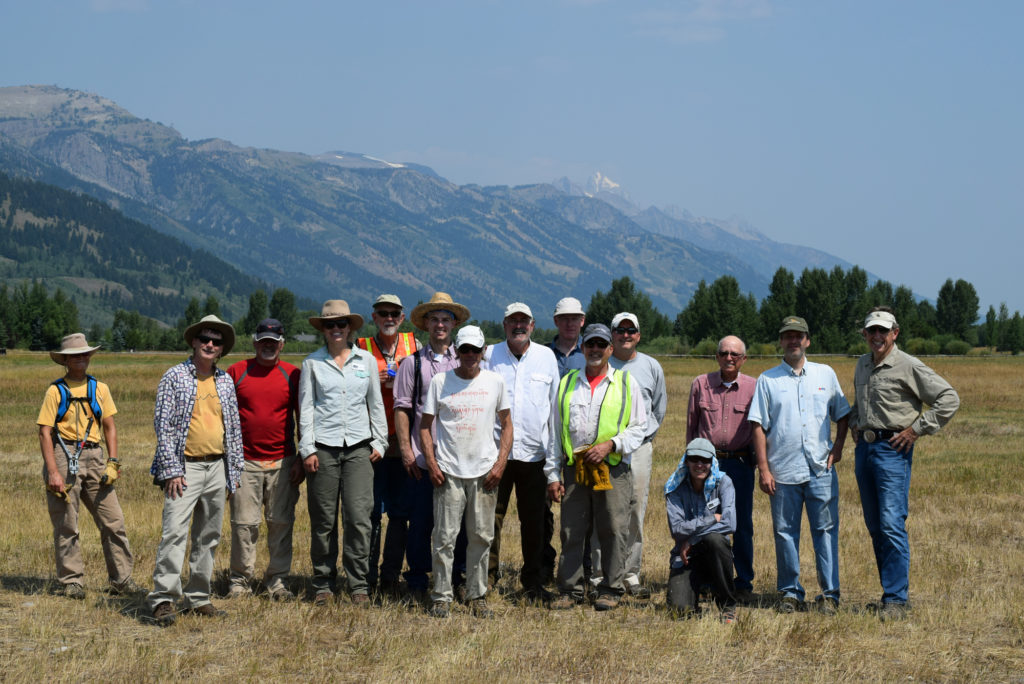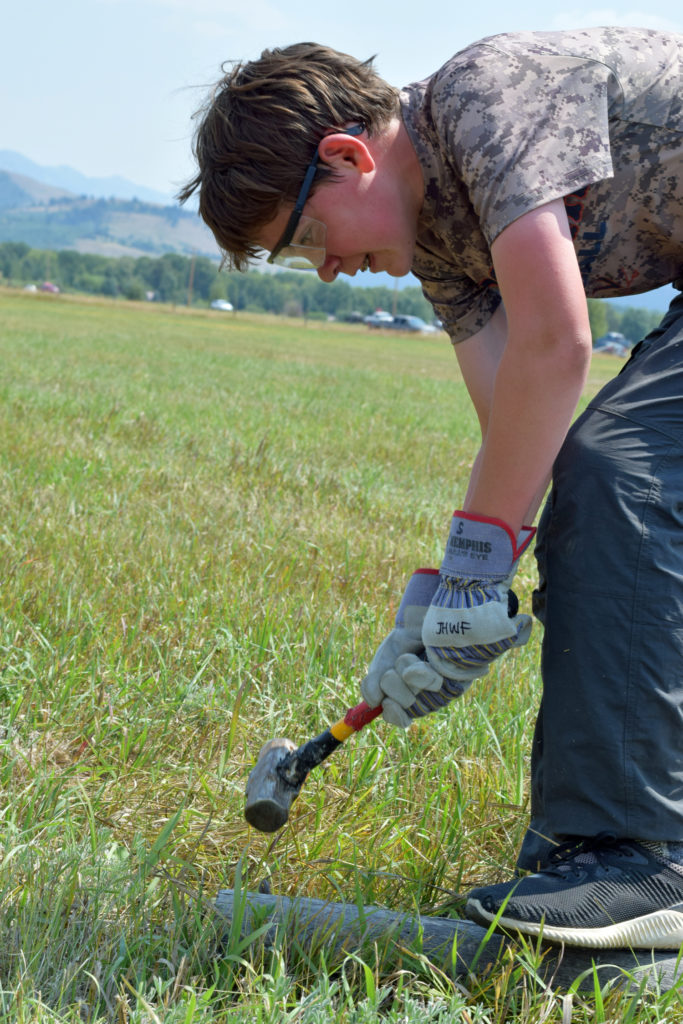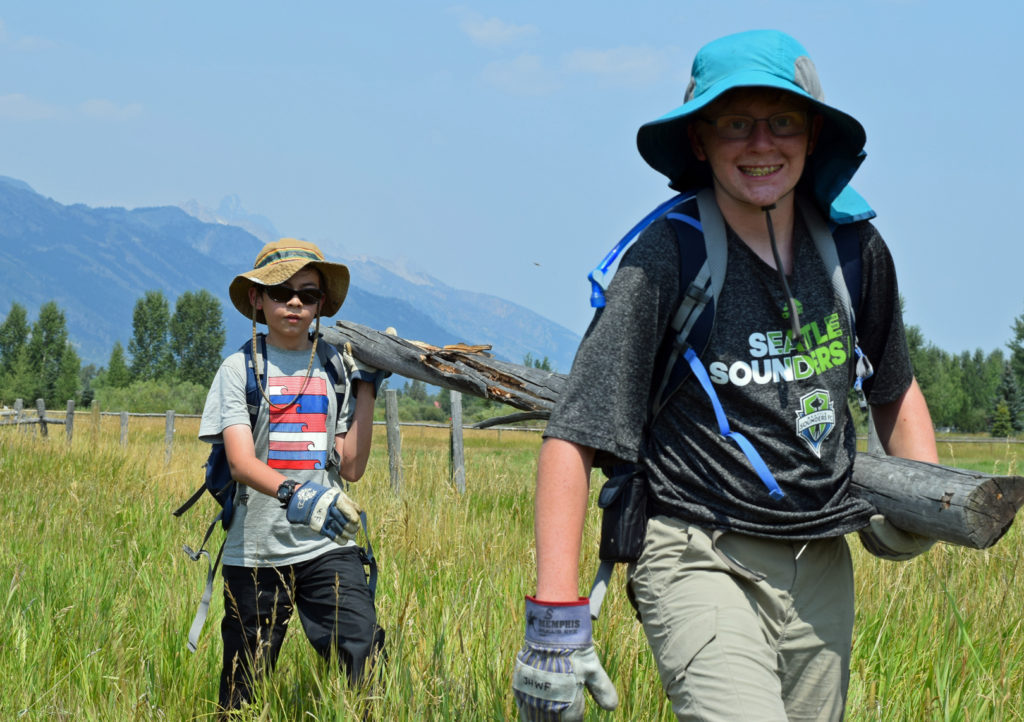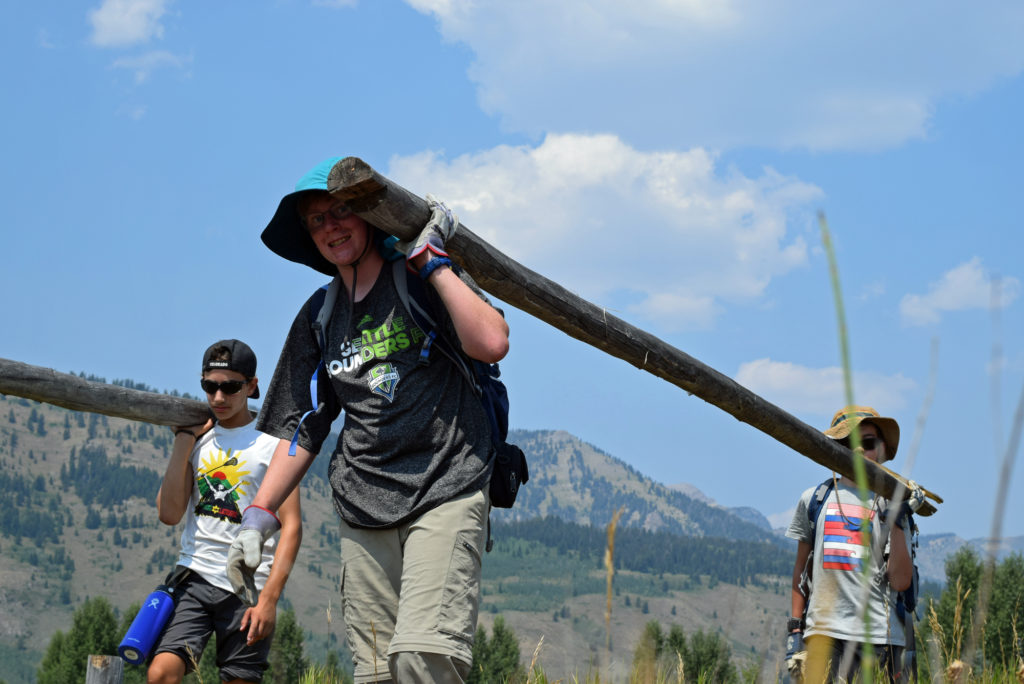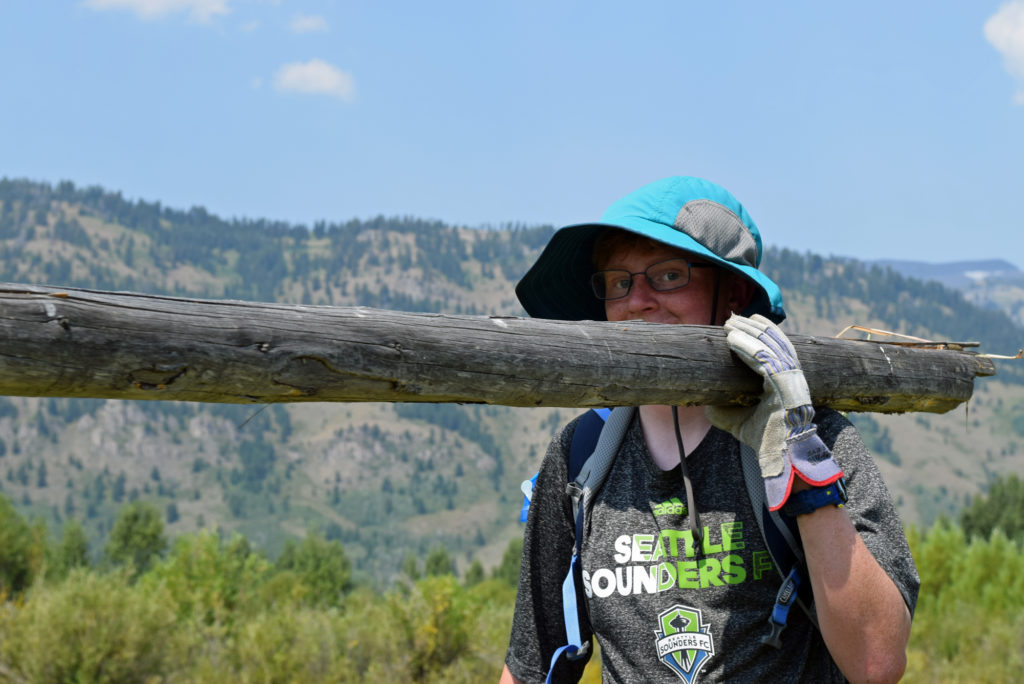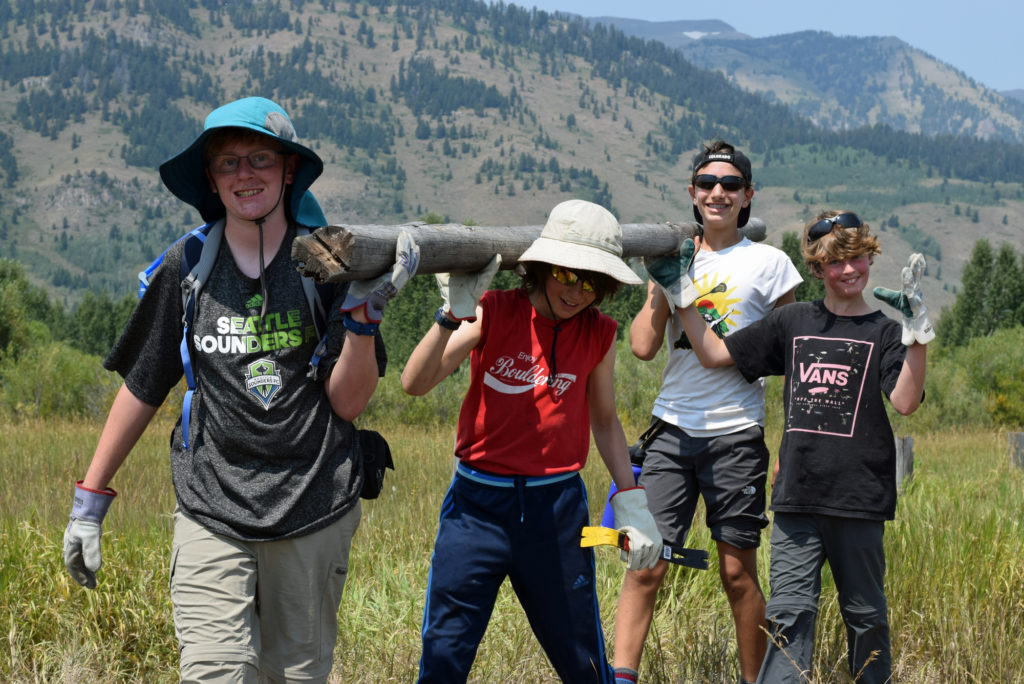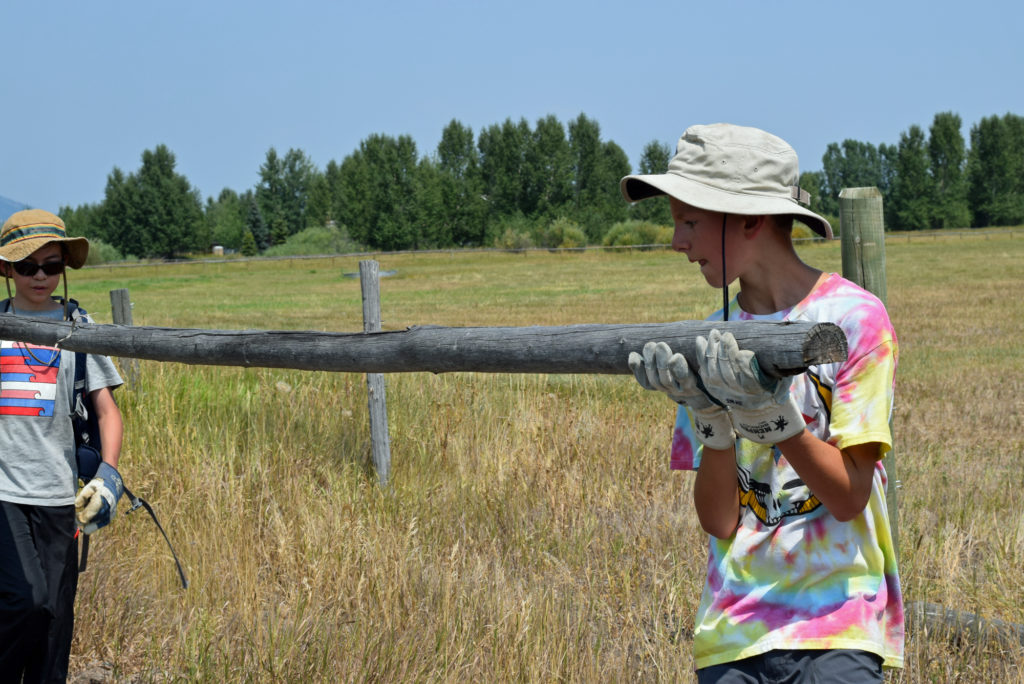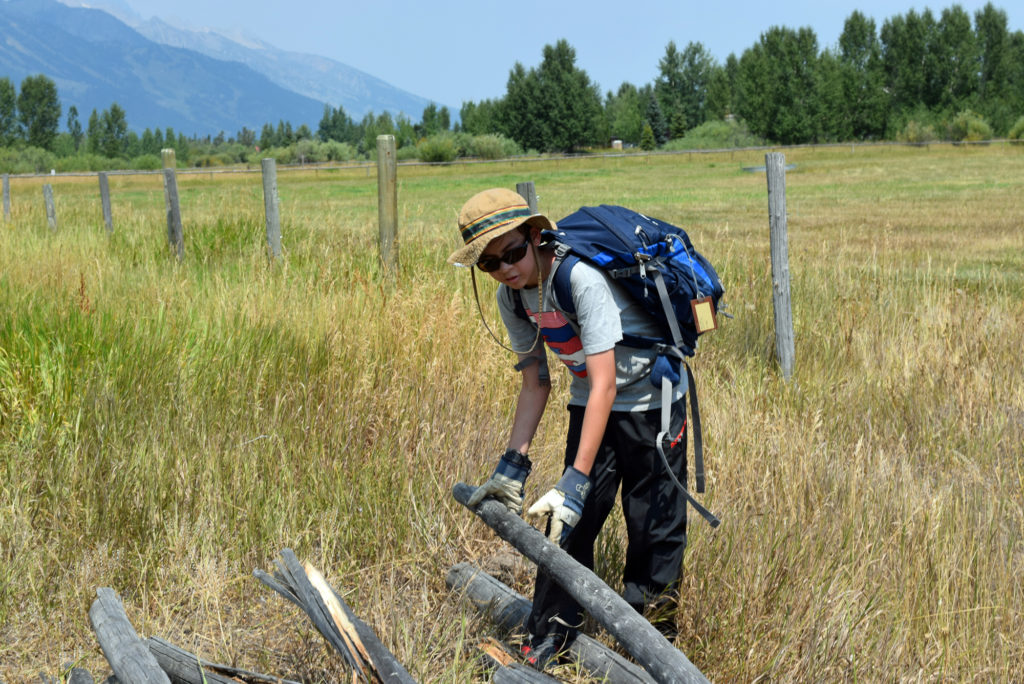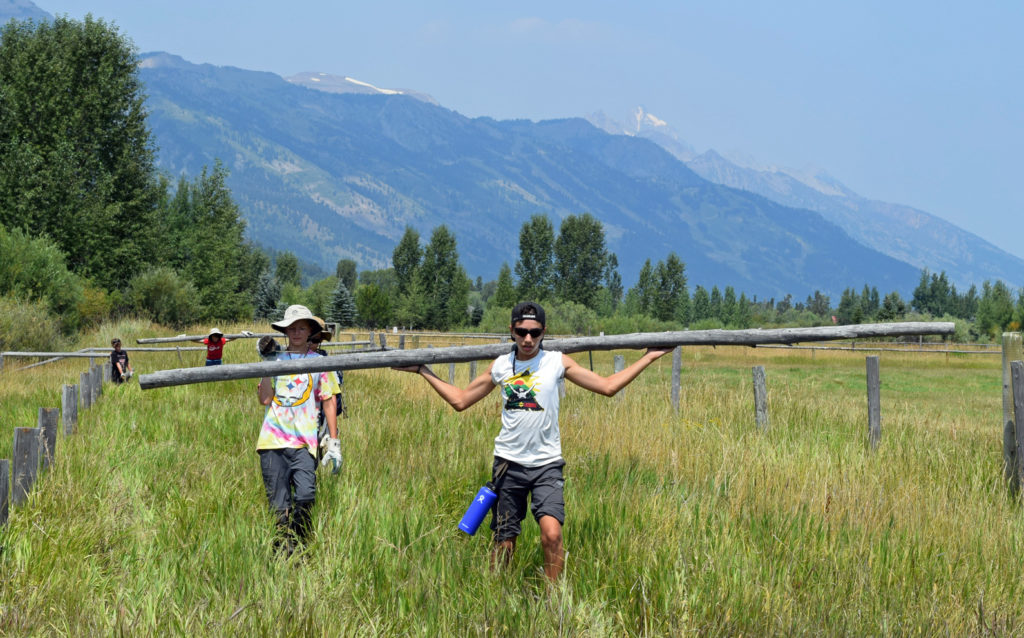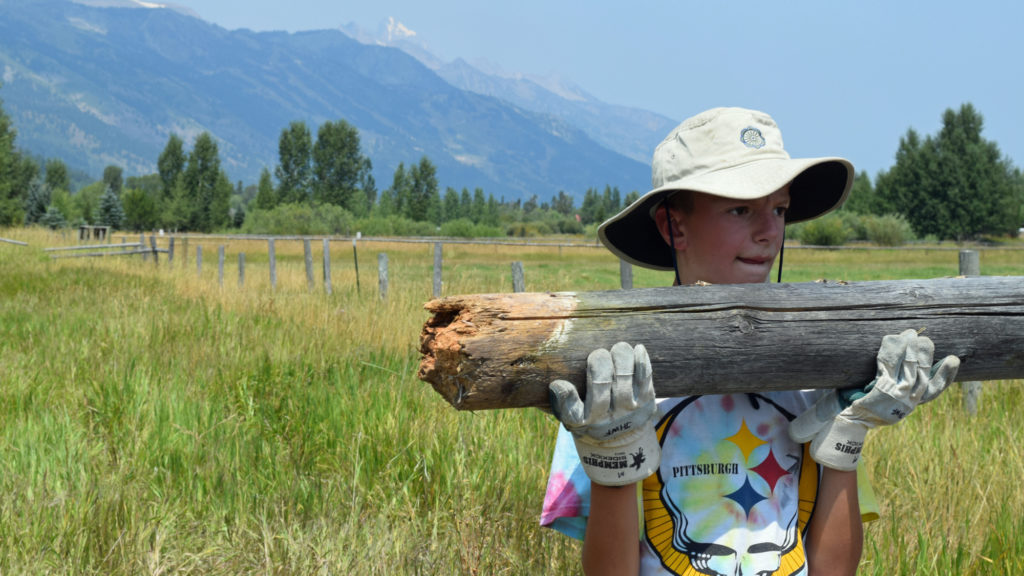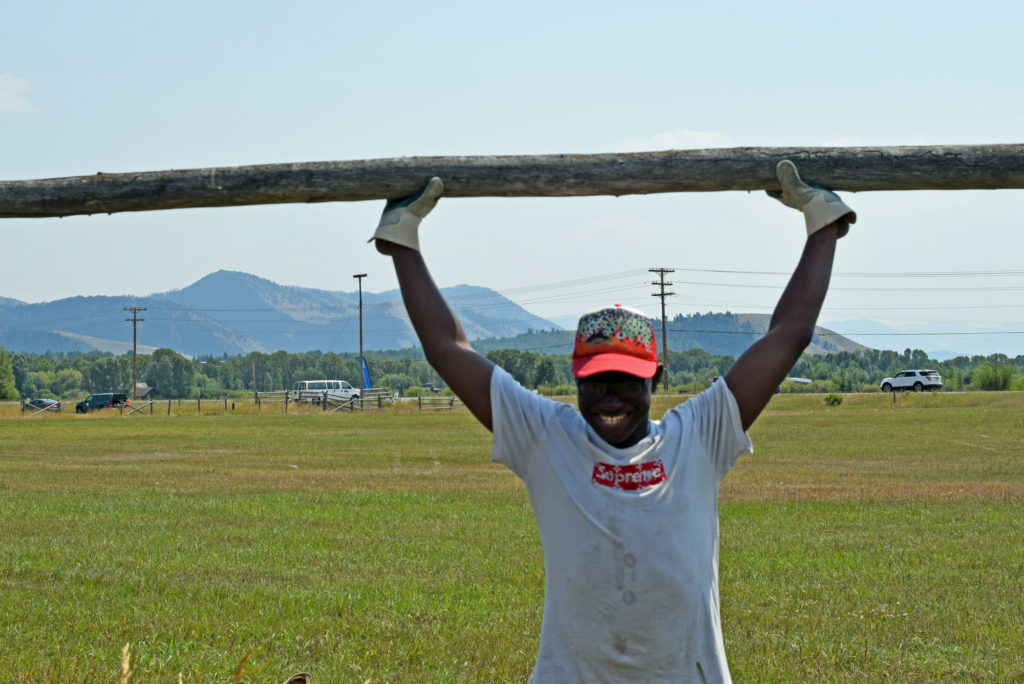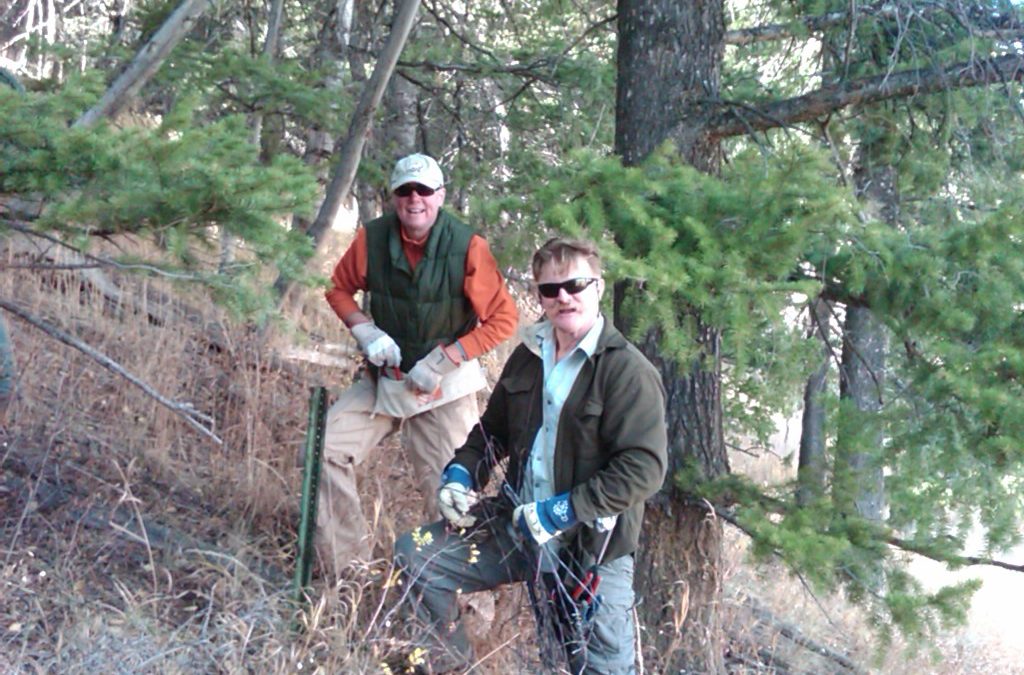
by jhwildlife | Aug 17, 2018 | Blog, Wildlife Friendlier Landscapes
by Jon Mobeck, Executive Director
For 25 years, Jackson Hole Wildlife Foundation (JHWF) has worked to reduce human-caused impacts on wildlife. One of our most visible programs, Wildlife Friendlier Fencing, began in 1996 when a small group of local citizens and JHWF founders organized group fence pulls on Saturdays. Over the course of the next two decades, hundreds of individuals (almost entirely volunteers) helped to remove or modify almost 200 miles of fence. There have been so many key contributors that it would be unwieldy to list them all here, but we recognize two of them today for their dedicated efforts in the field, and for their legacies that inspire our work well after their lives were ended much too soon.

Sue Colligan (left) and Greg Griffith were invaluable contributors to the Wildlife Friendlier Fencing program for many years.
Sue Colligan was the Executive Director of the Jackson Hole Wildlife Foundation less than a decade ago, and all who remember her speak to her incredible dedication to the fence program. My personal recollection of Sue was as a member of an early incarnation of the Safe Wildlife Crossings for Jackson Hole group in 2011-2012. While I represented The Murie Center for that purpose, Sue advocated for wildlife on behalf of JHWF. At those meetings (in Vance Carruth’s living room), Sue used her voice effectively and with intelligent precision. I think she could say in 20 words what I convey in 100. Those who joined her on fence pulls have also spoken about her steady resolve to get things done for wildlife. When Sue’s illness took her life too soon, she left a legacy gift to JHWF to continue its essential work. With those funds, we have been able to purchase supplies for the Wildlife Friendlier Fencing program, and in 2018 we used funds left by Sue to purchase a work truck, which has been used extensively to support our Wildlife Friendlier Fencing program (it carries tools and gear to every project) and our Nature Mapping Jackson Hole program (it carries bird banding supplies, mist nets and gear to field sites weekly throughout the summer.)
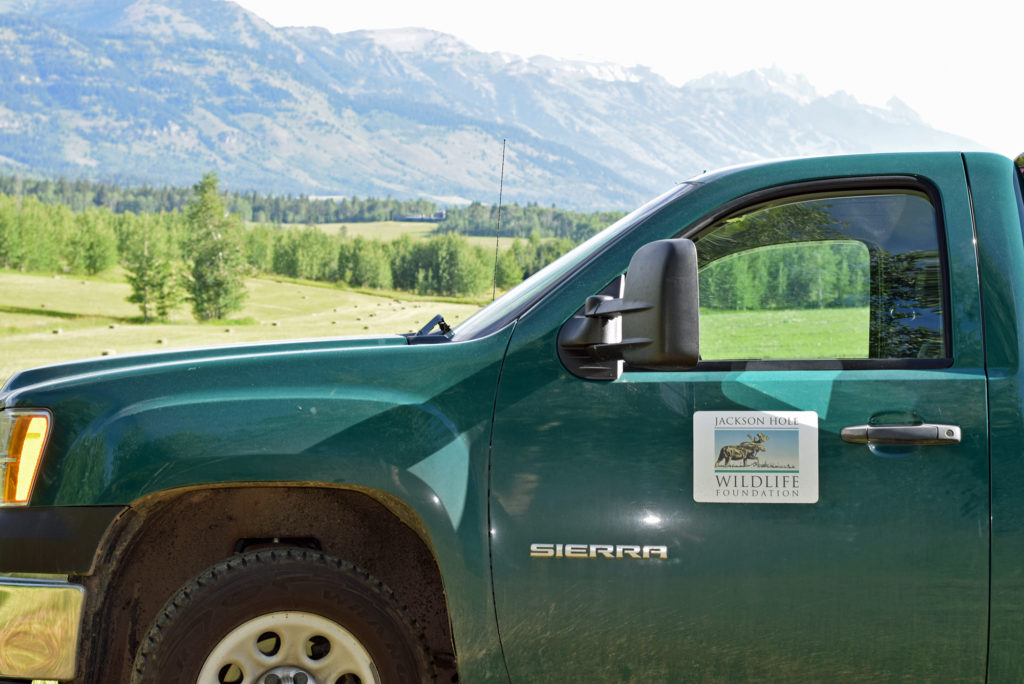
The Jackson Hole Wildlife Foundation truck sits ready for work at a Wildlife Friendlier Fencing project site in front of the Tetons.
Greg Griffith is known to many in Jackson as the unstoppable engine of the Wildlife Friendlier Fencing program for many years. A car accident took Greg from us very prematurely, but rarely a fence project goes by without someone mentioning Greg – his specific project methods, his concern for other volunteers, his fierce commitment to doing what is best for wildlife. Stories about Greg are now the stuff of legend, except there’s no indication that any of the stories are exaggerated, as many legends are. If someone says that he once carried six full rolls of barbed wire down a mountain and across a raging river, I’d have to believe it. It must have happened just that way. While I never met Greg, I feel that I know him through these stories, through the many volunteers who were deeply affected by him. When Greg passed, friends from far and wide made donations to JHWF in his honor. Now almost three years later, we still receive notes and occasional donations that reference Greg’s impact. He improved the lives of people as he made our valley better for wildlife. With the donations made in Greg’s name, JHWF purchased a cargo trailer to house all of our fencing tools and other JHWF field supplies. In the near future, we will place a graphic wrap on the trailer that promotes the program and the work of the many volunteers who have contributed to its success over the years.
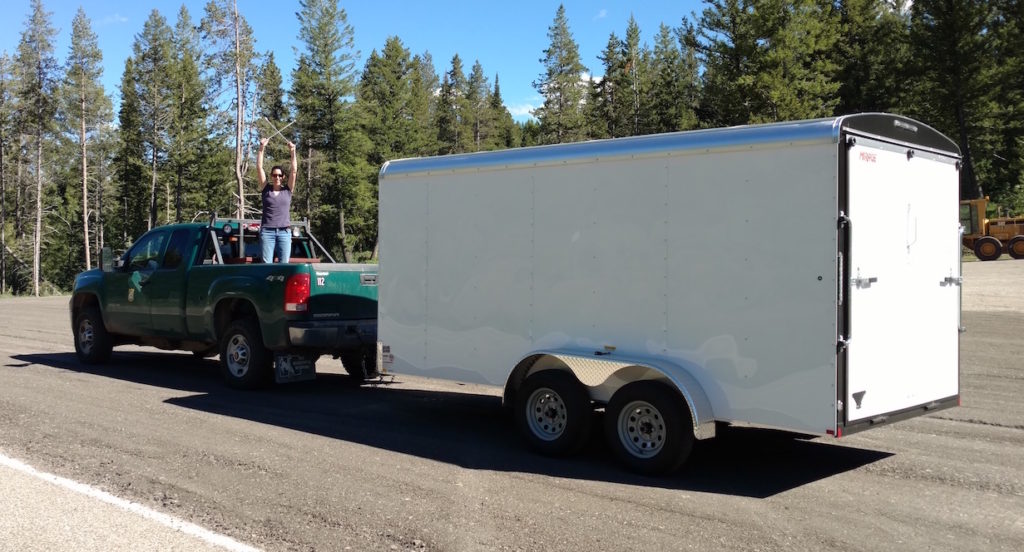
JHWF Board President Aly Courtemanch delivers the new cargo trailer to the JHWF office.
There are many people to celebrate in the history of the Jackson Hole Wildlife Foundation, likely none of whom really care to be celebrated. Many have done the work quietly and doggedly, on Saturdays, in the heat, in the rain. Whatever it has taken to get the job done. The legacy that follows all of these individuals is one of humble service to the wild community, to which we belong. May it ever be so.
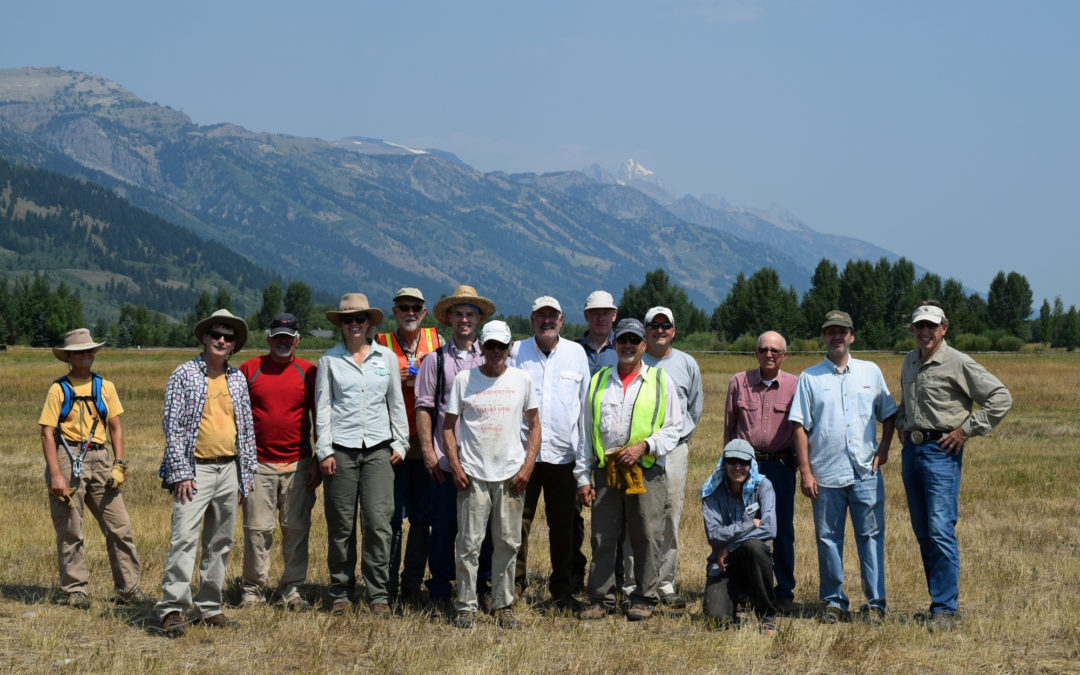
by jhwildlife | Aug 13, 2018 | Blog, Wildlife Friendlier Landscapes
by Jon Mobeck, Executive Director
Saturday, August 11 was the sort of sunny scorcher that forces even the most ebullient dogs to slink into the shade. These are the days that force siesta. Yet despite the 95-degree heat, 35 dedicated souls showed up to the Hardeman Meadows north of WY 22 to help Jackson Hole Wildlife Foundation and the Jackson Hole Land Trust improve fences for safer wildlife passage. Some of Saturday’s volunteers have been on most of our projects this year, which is remarkable itself, but especially gratifying when any of them could have chosen to sit this one out and stay cool. That’s just not the way these wildlife-nuts operate, though. They’ll be there. They’ll get it done. Amazing.
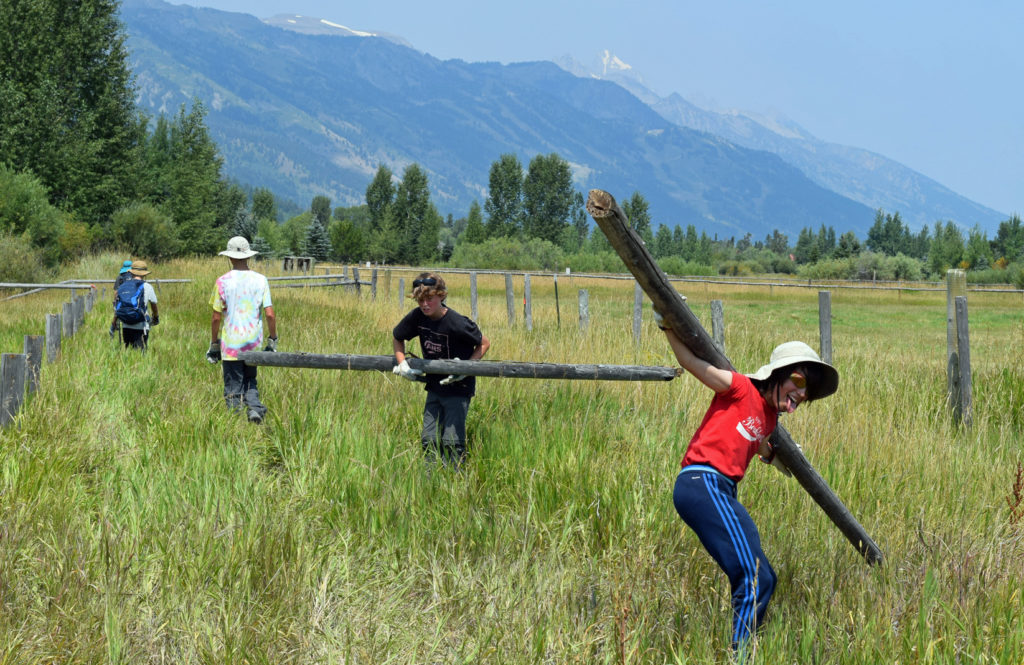
Eleven middle school students also joined us, arriving with three instructors from Teton Science Schools, to dislodge (demolish!) top rails on a fence that will be replaced. It wasn’t hard to inspire the kids to whack away with their mini-sledgehammers! They did great work and lifted us up in the hot afternoon with sunny dispositions. Thanks, boys!
By 2 pm, we had removed more than 3/4 of a mile of fence, and hammered staples into posts on a fence now lined with smooth wire that can be dropped to a single strand when the pasture is not in use – a standard Wildlife Friendlier Fencing modification. Importantly, all of the volunteers stayed well hydrated – few moments passed without someone shouting “are you drinking water?!” – and completed the project safely.
JHWF is grateful to its volunteer fence team leaders – Randy Reedy, Scott Landale, Steve Morriss, and Gretchen Plender – and to Teton Science Schools as well as the Jackson Hole Land Trust (especially Erica Hansen and Steffan Freeman) for another rewarding day making the landscape just a bit better for wildlife! We’ve now removed or improved 5.5 miles of fence this summer.
We’ll get after it again on August 25. Join the herd!
– Jon
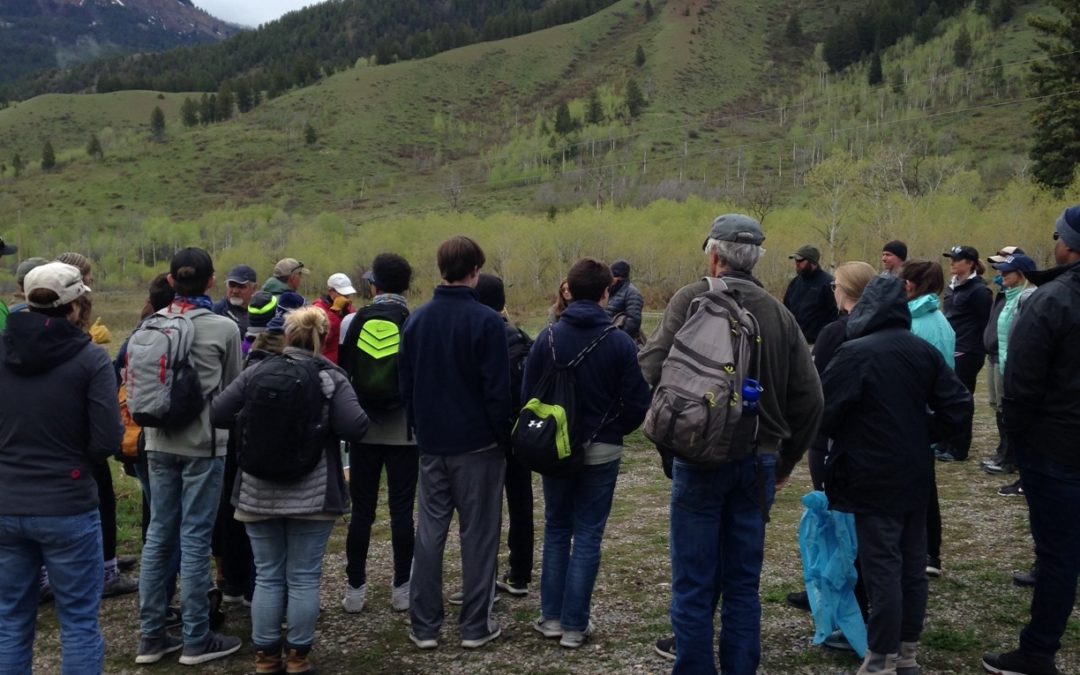
by jhwildlife | May 14, 2018 | Blog, Wildlife Friendlier Landscapes
by Jon Mobeck, Executive Director
A steady rain saturated the ground as I looked out the window. It was 5:30 a.m. on the day of a fence pull – Saturday, May 12. It’s hard not to feel that a bit more sleep would be a better choice than pulling down barbed wire fences, but that fleeting thought is dismissed as I think about the others who are doing – and maybe thinking – the same thing. I’ve done this work in the rain before, but nowhere near as many times as those key “Fence Team” volunteers who I would join later that morning. And then I have the thought of all the people who have done this over the past two decades, in all sorts of weather conditions, in any terrain. There was never really a doubt that we would pull down fence that day.
On this day, we were scheduled to benefit from a large volunteer crew generously offered by EcoTour Adventures. EcoTour was hosting a group of 16 students from a school in Louisiana along with an equal number of parents. While visiting (vacationing) here, the Louisianans would see the typically amazing sites of Jackson Hole, experience exhilarating adventures, and learn about the area’s wildlife and natural gifts from EcoTour’s exceptional guides. Because of EcoTour’s commitment to the area’s wildlife, they encourage their guests to participate in activities that help preserve what makes this place special.

On this day, though, with rain coming down and more rain forecast throughout the day, I had assumed that the group would cancel, and I wouldn’t have blamed them for a second. After all, they were on vacation. Pulling down barbed wire fences in the rain is not high on the “to-do” list for most of the vacationing public.
So at 7:22 a.m., when EcoTours CEO Taylor Phillips texted: “OK we are all in for the fence pull. Expected arrival 9:15. Yahoo!” I was surprised. I knew I would be meeting our indefatigable Fence Team volunteer leaders Gretchen, Steve and Randy since we had all decided that we were going no matter the weather, but now the prospect of our small team working through the rain turned into the excitement of a huge group (41) of us doing so together.
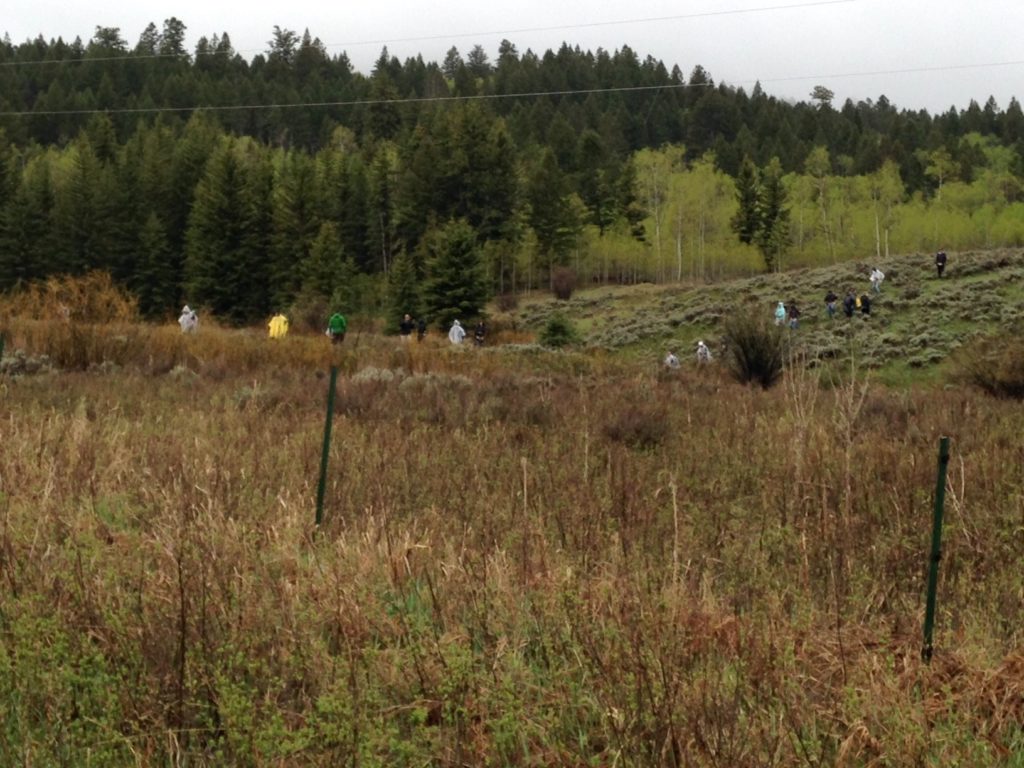
As it turned out, the rain was relatively light throughout most of the project, and I was amazed by the resilience of the Louisianans. I suppose they are accustomed to rain, but as one of the parents – James – said, “We don’t get to do anything like this in Louisiana.” The Louisianans worked for 3 hours with us, and it sure seemed like they were having a good time. That knowledge filled me with joy. Here all of us were, in the rain, removing barbed wire fences to make things easier for wildlife. And it was fun! And it reminded me of how great it is to share such an experience with new people, from a different place. We’re all so similar, and we all can do so much together!
Of course, we do this for the wildlife. On this occasion, we worked in an area at the northernmost end of the recently mapped Red Desert-to-Hoback Mule Deer Migration Route. The Wyoming Migration Initiative elucidated this 150-mile route through extensive GPS collaring and subsequent mapping that is now recognized and discussed around the world. Each spring, mule deer that were once thought to be a resident population of the Red Desert region migrate across and through many roads, houses, industrial developments, and about 100 fences before finding summer range in the greater Hoback area. We worked near those summer ranges, where they will spend considerable time, removing obstacles that can separate fawns from does, and just generally make their route more challenging.
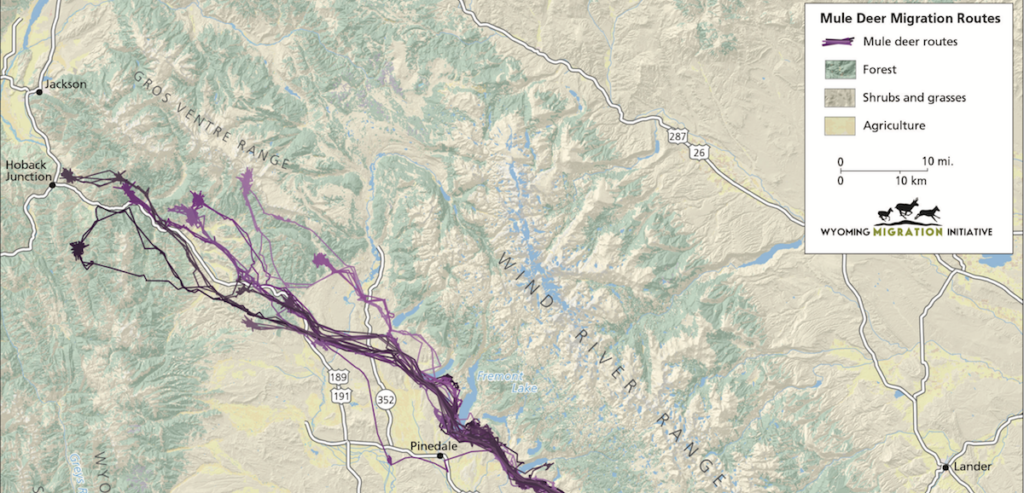
The northern end of the Red Desert to Hoback Mule Deer Migration Route, as identified by Wyoming Migration Initiative, which includes summer range for mule deer.
We were on Bridger-Teton National Forest Land, where we removed about ½ mile of nasty barbed wire fences. It is a privilege to be able to support our agency partners who couldn’t possible deploy enough staff members to remove or maintain every fence in the region. Our volunteer fence pullers pitch in to care for our public lands in partnership with those terrific land managers.
Hundreds of individuals have helped in this way over the past two decades. Some of whom have been on hundreds of fence projects. I’m personally grateful to all of them, and when I pull my boots on to go work on fences, I know that I’m part of something much bigger than me, in so many ways. It is a big, impressive landscape. It is an amazingly long mule deer migration. There are so many people over many years. There is still so much to do.
Thank you to those great young people from Louisiana and their parents, and to EcoTour Adventures. We’re all a part of a great tradition of giving back to the land!

by jhwildlife | Aug 18, 2017 | Blog, Wildlife Friendlier Landscapes
by Jon Mobeck, JHWF Executive Director
This is a little story about a deer and a fence in Minneapolis, Minnesota, where I am today.
I was driving down busy Excelsior Boulevard when I saw a doe and fawn gallop across two lanes, then a tree-lined median, then two more lanes and a sidewalk before the doe leapt over a short woven-wire fence that marked the boundary of a golf course. The fawn, however, had no idea how to do what its mother had just done. While at a stoplight, I watched the fawn slam face-first into the short fence, then scamper along the fence line for a hundred yards or so before smashing its nose into the wire again.
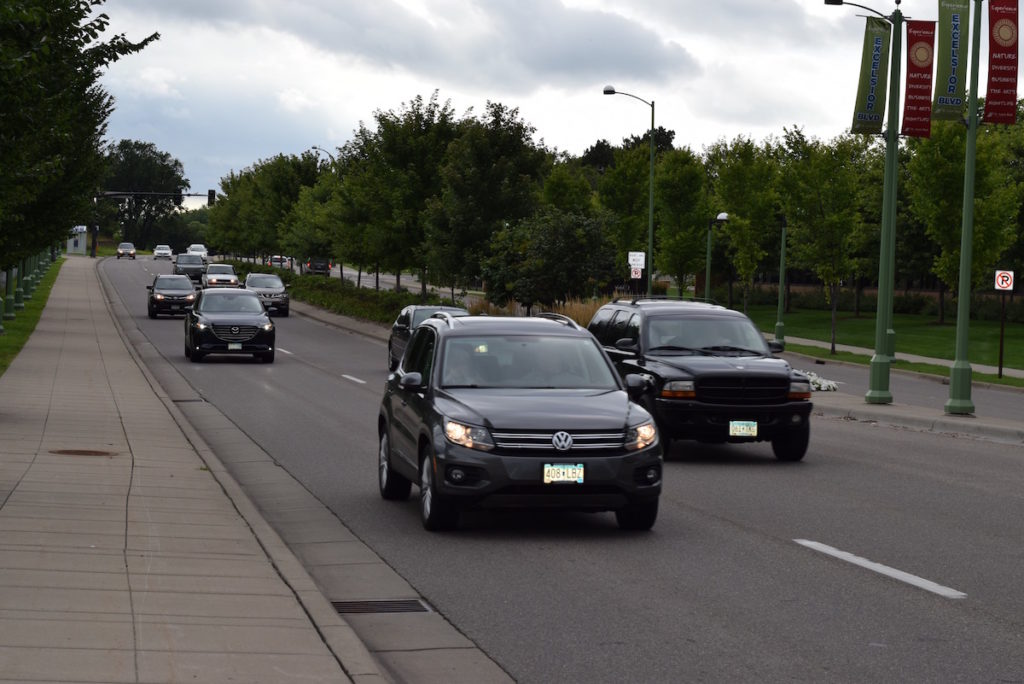
The fence is at far left of this picture of busy Excelsior Boulevard.
When the light turned green, I did a quick u-turn and pulled to the side of the shoulderless road. I activated my hazard lights and jumped out of the car to see if I could capture the fawn and help it over the fence – or at least shepherd it several hundred yards west to a gap in the fence. Neither of these things proved easy to do. The first few times I approached, the fawn blitzed by me racing full speed along the fence line before pausing to make another headlong charge into the woven wire. After many of the failed ramming efforts, the fawn would dart crazily back out into traffic. Although traffic was moving at about 45 mph on that stretch, the fawn fortunately found gaps as it darted about. It never crossed over the median again, always returning for another charge at the fence. Slam! Crash! The doe stood tall on the opposite side of the fence, and mirrored the fawn’s movement east and west along the fence. During all of this time, the fawn rarely ceased bleating, while the doe communicated in brief, huffing pleas.
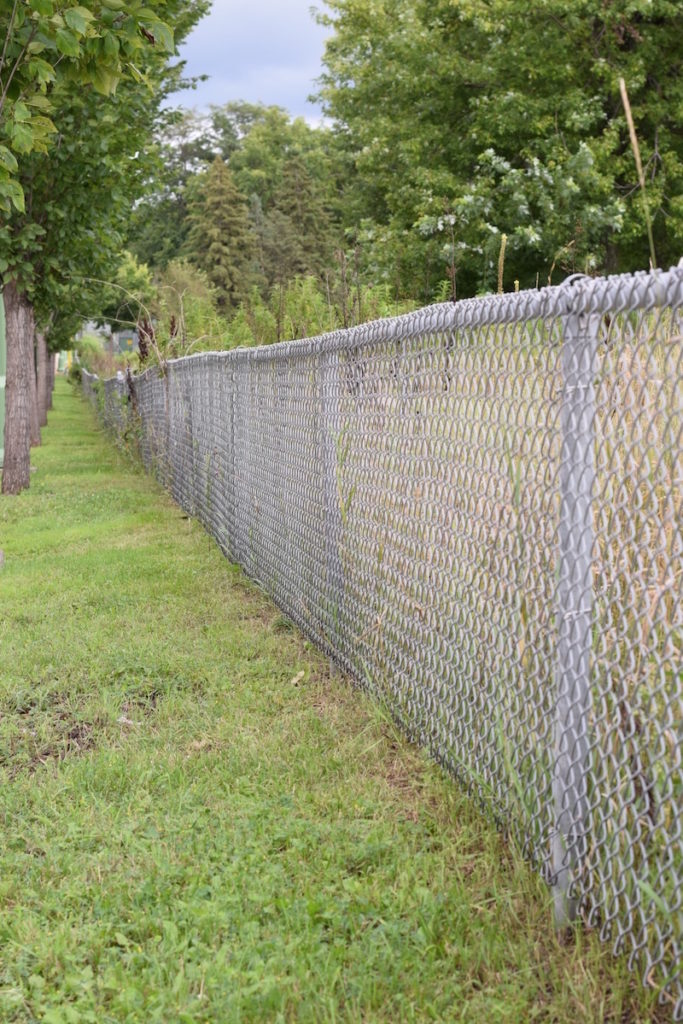
For almost a quarter-mile, the fence was unbroken.
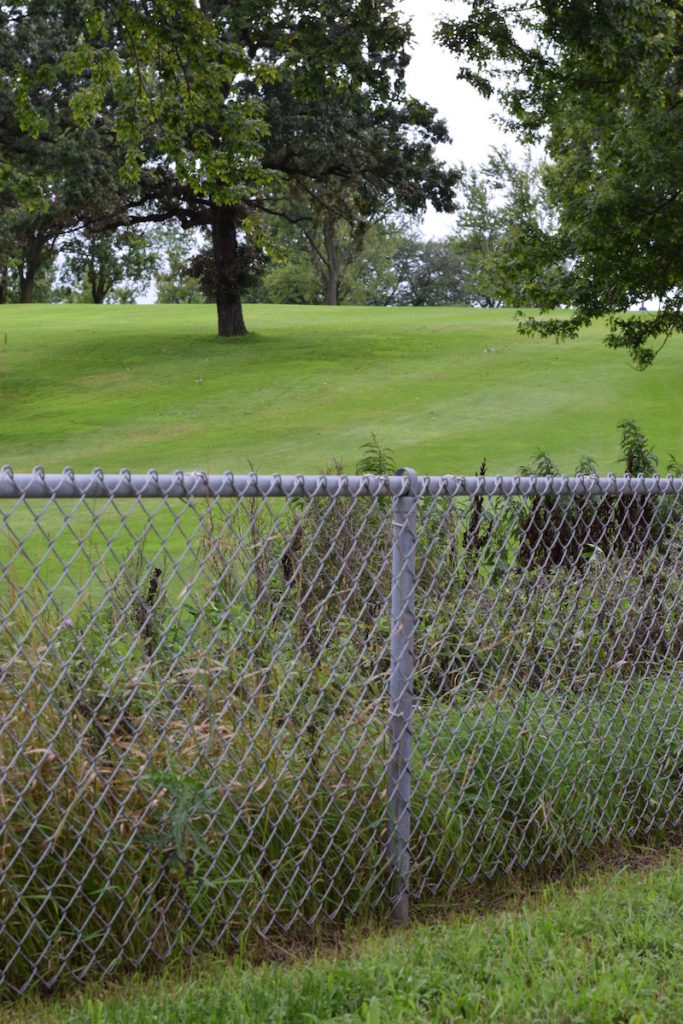
It was about 30 inches high.
As I tried, unsuccessfully, to shepherd or catch this panicked fawn, a young woman came running down the sidewalk toward me. She wanted to help. Without discussing strategies, we assumed the positions of border collies and tried to surround the fawn from opposite sides and “corner” it against the fence, hoping for a chance to catch it. This almost worked, but the fawn squeezed past the woman and darted back onto the road, except now the traffic had stopped, with the two lanes backed up, recognizing what was taking place and thankfully waiting for resolution. After we both watched the fawn race along the fence and slam into it a few more times, thinking it would never slow down, and never stop panicking, the fawn did slow down, and it did seem to stop panicking for a few seconds. It trotted back down the boulevard toward us and as it approached, it walked slowly toward the fence and stopped right between me and the woman. We formed a triangle with the momentarily calm fawn at top near the fence. We slowly stepped toward it and the fawn turned along the fence toward the woman and made a little leap as if to run, jumping (kind of miraculously) right into the woman’s arms, where she easily lifted it over the fence and set it down on the other side. It scampered away in a rush. The doe did not chase after it, but stood very erect, vocalizing. The doe stamped its feet, and took a few measured steps toward the crazed fawn, which was running endlessly, and in circles. After a few moments, the fawn slowed, and then galloped toward its mother.
I don’t know what happened to those deer after that moment, but they were safe for now. The woman and I high-fived each other. She remarked that she was a little worried that she might get kicked. I was impressed by her skill in corralling the bounding fawn in one giant bear hug, her willingness to risk injury, and her desire to help in the first place. Her car was pulled behind mine, also with its hazard lights flashing.
As we were high-fiving, we heard car horns honking in approval. A woman leaned from the driver seat toward the open passenger window to shout “thank you!” A man in a garbage truck yelled “good job!”
Although I sometimes hear people reprimand those who “anthropomorphize” wildlife, it’s impossible to witness an event such as this one and not understand the emotions, the stress, the communication, the concern experienced by a mother and its offspring. They are navigating this planet with us. We are sharing a life that will end with each of us representing a miniscule segment of the unfathomable span of history. No life is more important than any other.
At JHWF, we talk about creating permeable landscapes. We aren’t necessarily focused on how many animals die because of fences, or even how high our fences are – any uninterrupted fence can be a problem. We focus our efforts on how well we are ensuring that the large and small animals can move across a landscape we share with them. Where can and should we create gaps in a fence, for passage above and below? How can animals navigate our development, our neighborhoods, our roadways? A community that lives compatibly with wildlife considers these things daily.
Thanks to hundreds of volunteer heroes, the Wildlife Friendlier Fencing program has removed or modified 188 miles of fence, including nearly five miles this summer. A lot of fawns and calves have had an easier time because of this work. We often think about the height of a fence in relation to how high we know an adult deer or elk can jump. The story of a young whitetail deer in Minneapolis tells us we might benefit by expanding our thinking.
Next Saturday, August 26, we have a project in Game Creek on hillsides frequented by deer and elk. It’s a fence with three barbed wires and a top rail. It’s not hard to imagine a fawn approaching such a fence and trying to ram through it, as was the preference for the fawn in Minneapolis. If the bottom wire is high enough from the ground, the fawn might be able to sneak under, but in a panicked state with developing legs and unrefined navigation skills, it may not make it. So how many fawns and calves get separated from their mothers because of the barriers we raise?
Despite these concerns, what I’m left with after my experience with the deer and the fence in Minneapolis is the potential of people to do good things, to be of service to others, to embrace ethics that connect people with each other and to the wild things that live upon the same land. We have incredible potential, despite the degree to which our more suspicious natures question the goodness of people – a reflection of an increasingly skewed version of reality that focuses on every isolated negative activity within oceans of good deeds done daily, if quietly.
The young woman who stopped to help me inspires me, although I never learned her name. She took a few minutes out of her day to get a deer over a fence. The people who stopped their cars, those who honked, those who cheered and thanked us, they represent the better angels of our nature. We live in a world with beautifully wild things, and we are they.
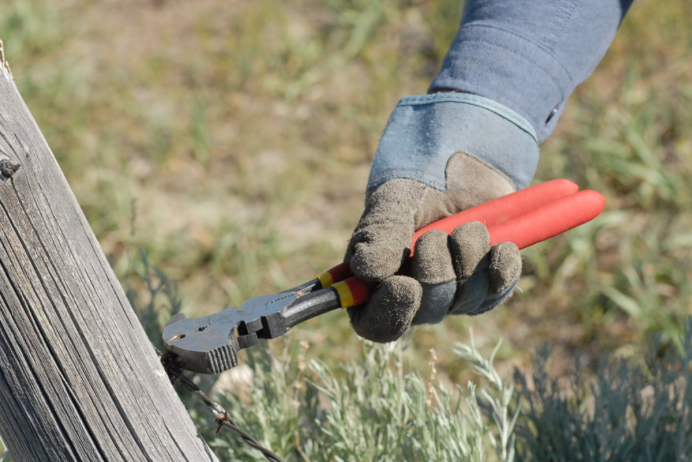
by jhwildlife | May 19, 2017 | Blog, Wildlife Friendlier Landscapes

Please join us Saturday, June 3 at Buffalo Valley Swan Pond, Bridger-Teton National Forest to volunteer to help with the removal of barbed wire and smooth wire fences.
Project Details
For our first public project of the year, we plan to remove .5 miles of barbed wire and smooth wire fencing in prime wildlife habitat in the Buffalo Valley. The work area is scenic and the terrain is flat and easily traversed. This project assists our partners at Bridger-Teton National Forest as they aim to make important habitat more permeable to wildlife movement.
The project is average in difficulty (3 on a 1-10 scale).
We will meet at two car pool sites:
- Home Ranch Parking Lot (north side) at 8:15 a.m.
- Gros Ventre Junction at 8:30 a.m.
We will carpool from these sites to the project. We plan to work from 9 a.m. to 2 p.m. and half-day (morning) is welcome, as well. We will provide water, Gatorade and snacks. Please bring your own water bottle or hydration packs. We will take a mid-day lunch break so please bring your own lunch.
Gear: You should wear layered clothes, long pants, sturdy shoes, and bring a rain jacket in case of storms. Sun or eyeglasses are a MUST for working with barbed wire. Sun protection (hat & sunscreen lotion) is also recommended, and will hopefully be necessary! We also recommend that volunteers check the status of their tetanus shots, in case of scratches from the old fencing material. We will provide work gloves and tools.
Please RSVP to jhwffencepull@gmail.com if you plan to attend and let us know at which car pool site you will join us (1 of 2 locations listed above). You can also send questions to this same email address. Additional last-minute information on this event will be posted here.
See you on June 3!

by jhwildlife | May 2, 2017 | Blog, Wildlife Friendlier Landscapes
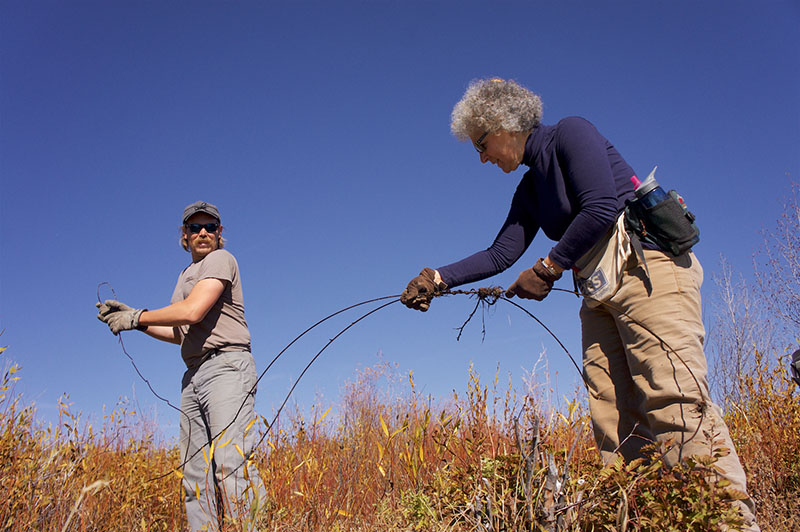
The Jackson Hole Wildlife Foundation has announced dates for its public fence projects in 2017 following its winter and spring of project coordination and site reconnaissance. The Wildlife Friendlier Fencing program reduces dangerous and challenging barriers to wildlife movement.
Public projects offer volunteers the opportunity to contribute to the removal or modification of fences that pose avoidable threats to wildlife while fragmenting vital habitat. JHWF and its “Fence Team” leaders also work on a number of private projects with landowners throughout the summer toward the same end.
Public fence projects typically occur on Saturdays usually from 9am – 2pm with a lunch break. On some projects, half-day “shifts” are available. While listed dates are subject to change or cancellation due to weather and other conditions, JHWF encourages volunteers to save the dates in order to ensure that all can participate as their schedule allows.
JHWF will require an RSVP from each volunteer in advance to ensure that we have the ideal number of volunteers for each project. Interested volunteers receive an email invitation and RSVP request about two weeks prior to the project date with the description, details and other logistics outlined. Please email jhwffencepull@gmail.com or info@jhwildlife.org if you are not currently receiving fence project updates and would like to, or if you have questions about volunteering.
Wildlife Friendlier Fencing Public Project Dates 2017:
- June 3
- June 17
- July 15
- July 29
- August 12
- August 26
- September 16
- September 30 – Public Lands Day
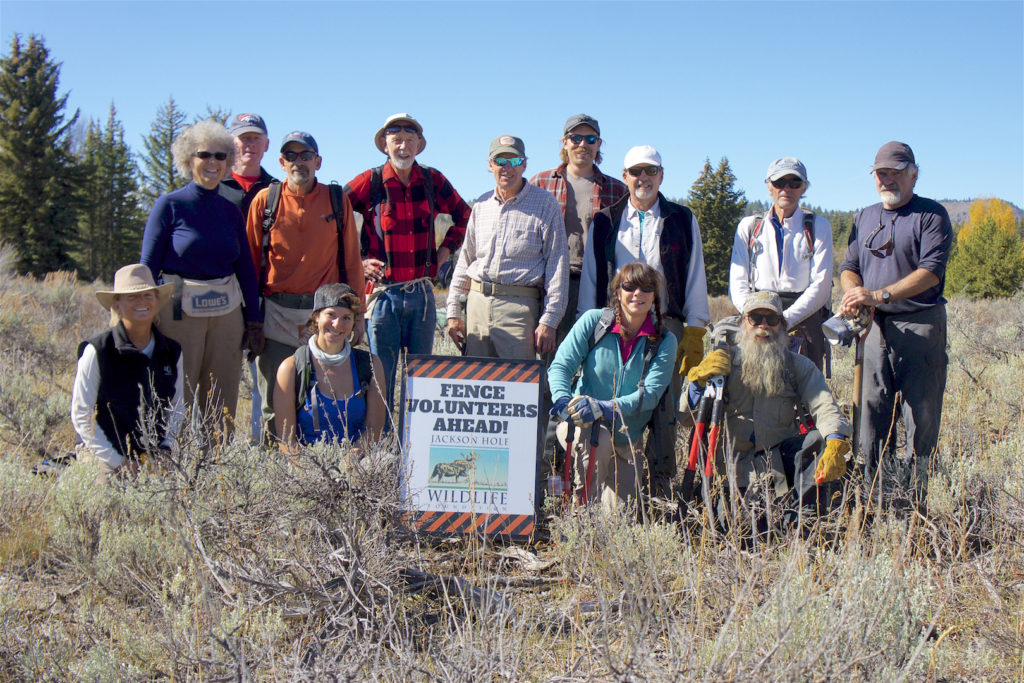
Photo credits: Sava Malachowski







